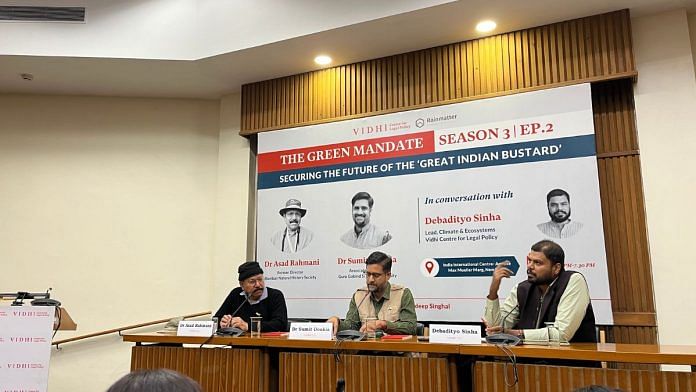New Delhi: Sumit Dookia’s first sighting of the Great Indian Bustard was in Bikaner – he needed to ask the conservationist beside him what the creature that stood before him was.
Two decades later, a lot has changed. There are no bustards in Bikaner and Dookia knows the remaining down to their last feathers.
The Great Indian Bustard dominates headlines from time to time – demanding urgency and being thrust into a spotlight that birds are seldom given. However, creating conversations doesn’t always lead to change. At a discussion in Delhi’s India International Centre – part of the Vidhi Centre of Legal Policy’s ‘Green Mandate’ series on hot-button environmental issues – an impassioned group of panellists reiterated that the bustard’s days are now numbered.
Jaisalmer, with its fledgling population of captive birds and a handful in the wild, is the bird’s final talisman – and on the verge of becoming its final resting place. “Which way do we go? There’s no way to save the bird. The decline has been massive, and our only hope is in Jaisalmer,” said Dookia, a wildlife biologist and a professor at Guru Gobind Singh Indraprastha University.
To save the bird, officials and conservationists are taking on increasingly insurmountable hurdles. There’s the loss of habitat, the bustard-killing power lines vital to green energy infrastructure, and the bird itself. The bustard, as is its keep, ventures beyond its protected area, lacks peripheral vision, has a big head, is notorious for flying directly into power lines, and, of course, dying.
“The problem also lies with the species itself,” said Dookia. “There’s no point in expanding the protected area. It’s a very sensitive bird, and we’ve also had issues with community-level advocacy.”
It was only in 2012 that the bustard made its way into local life in its home state. According to Dookia, who is from and has worked extensively in Jaisalmer, it had no cultural footprint. Creating one was a conscientious effort on the part of conservationists and authorities to buttress its survival strategy. There were no motifs, no bustard prints in homes, and no folk songs.
Don’t blame climate change
Asad Rahmani, arguably one of India’s best-known ornithologists and key to placing the bustard in the national line of vision, was asked about the role climate change has played in hastening the bird’s downfall.
But according to him, when it comes to the Great Indian Bustard, climate change is just a mirage and not a real threat.
“Climate change is the bogey. The bird is adaptable and climate change is used to divert attention from real issues,” he said. “It used to live across the country, from Haryana to Tamil Nadu. These states have different climates.”
Its biggest threat, as for all animals, is humans. And government neglect. According to Dookia, wild bustard numbers haven’t been counted since 2018. There’s only been a focus on the captive birds – beneficiaries of Rajasthan’s ambitious conservation breeding programme.
“The problem is the wires being erected every single day. This is what needs to be emphasised,” Rahmani, former director of the Bombay Natural History Society, added.
A Supreme Court verdict should have been a vindication of the good fight. In 2021, the court recommended that power lines be taken underground and bird diverters be installed where overhead power lines already exist. This was in response to a petition filed by former IAS officer MK Ranjitsinh in 2019.
But earlier this year, power companies took to court saying that the 2021 order was impeding their business prospects in Thar and Kutch.
“If there’s a will to do it, we can do it. But there’s no will to save the bird right now,” said Ranjitsinh, who was part of the audience. “They [the government] want the bustard to go because they’re hampering development. There have been accidents wherein vehicles have been sent to clear bodies of bustards. This is the kind of subterfuge that’s going on.”
Also read:
‘Failure isn’t an option’
Conservationists present at IIC were in two minds when it came to the conservation breeding project. For Rahmani, these captive bustards are a “supplementary” – not an alternative to a thriving population in the wild.
“Conservation breeding will be successful only if a habitat is there. It’s been done successfully in countries abroad,” he said. “It’s a stock population. We have to carefully select which ones will be released. They need to be young and there needs to be minimum human interaction. Failure is not an option.”
But even as it dominates mainstream environment discourse, the on-ground impact is minimal and the bustard is en route to extinction. “There is passive resistance. When was the last time a party made an environmental issue their mandate?” asked Ranjitsinh.
The discussion ended on a simple, school-like note – what ordinary citizens can do to save the bustard. There was only one answer, from Rahmani: “By voting for the party which talks about conservation.” It was the ornithologist version of a mic-drop.
(Edited by Zoya Bhatti)







Sharing the added cost of taking the power lines underground would help bring perspective.
The nation has enough bastards. It does not need more.